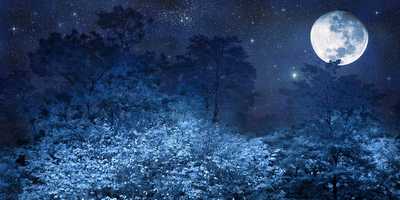Two full moons will grace our skies in July 2015. The first full moon will appear on July 2, 2015; and the second, rarer, Blue Moon will rise on July 31, 2015.
Why care about what’s happening in your sky? What a wonderful opportunity to be present in the moment, to witness what is happening as it rises.
Also, moon rise, and other celestial happenings are quite the lovely phenomenon to behold. These publicly and freely available events point to a collective community of living things: As Above, So Below; As Below, So Above.
It’s good to have reminders to Be Here Now. July’s two full moons are a great chance to practice that, with gratitude.
Can’t get excited about a moon rise?
Reading More: The Science of Blue Moons
Since the early 1930s, two full moons in the same month, traditionally—and erroneously—have been called a Blue Moon. However, according to a Sky and Telescope article, this double-month-full-moon phenomenon likely has more to do with the number of moons in a Tropical Year (from one “winter solstice” or Yule to the next is 13 full moons), as opposed to the number in a Calendar Year (from January-December there are 12 full moons). A technical detail, true; but interesting all the same how data transmutes over time, as it is processed individually into the collective and then reprocessed again from the group collective, back to individuated individuals.
An Earth Sky News article explains about the 19 year Metonic Cycle and the science behind why some months predictably have two full moons, and other months don’t. Another article from The White Goddess looks at the history of full moons, their different names in different times and suggests that the term Blue Moon is most likely a creation of folklore, formed and handed down over time.
The article Blue Moon Facts and Trivia on in5d, points to the ecclesiastical calendar for the reasoning behind a Blue Moon:
“Some years have an extra full moon—13 instead of 12. Since the identity of the moons was important in the ecclesiastical calendar (the Paschal Moon, for example, used to be crucial for determining the date of Easter), a year with a 13th moon skewed the calendar, since there were names for only 12 moons. By identifying the extra, 13th moon as a blue moon, the ecclesiastical calendar was able to stay on track.”
Sometimes, the geophysics of the planet actually make the moon look blue to the naked eye. As cited by Richard Giles in the article Once in a Blue Moon:
“When the Indonesian volcano Krakatoa exploded in 1883, its dust turned sunsets red & green and the Moon blue around the world for almost two years. In 1927 a monsoon in India set up conditions for a blue moon. And the Moon in Newfoundland was turned blue in 1951 when huge forest fires in Alberta pushed smoke particles high into the sky blanketing its light.”
Grass Roots and Native Understandings of Full Moon Significance
Try a Google search for “Blue Moon” or “Full Moon” and it will be plain to see all the various interpretations of these celestial happenings, over time. Many people have many opinions about the meaning or significance of a Blue Moon. There is definitely a lot of interesting data out there. Whether or not the data is all true, remains to be determined; however, exposure to such data is not only interesting, but potentially illuminating and definitely thought provoking.
Femininity, communication, the metal silver and intuition are time-honored symbolic attributes of the moon as discussed in Symbolic Meaning of the Blue Moon. In What Does A Blue Moon Signify?, Rebecca Griffin suggests that the full moon is about spiritual purging and letting go, with the second full moon that month, intensifying the purge.
Following in that same vein, the website Wildflower Parapsychology offers that the moon cycles impact weather patterns and people patterns too, while also holding:
“a great deal of significance when it comes to energy fields and such. Like all full moons, the blue moon heightens activity, awareness, and abilities. Even more, the double blue moon, because of its unusual cyclical nature, has an impact on the Earth, weather patterns, and tidal currents. The ancients viewed this quite differently than we do, today. Many ancient cultures had a built-in shift in the cycle of lunar months to account for the normal blue moon, leading to the existence of the ‘thirteenth month’ which, in many cultures, was known to be a time of great power and energy, when the most powerful rituals and rites were performed. A double blue moon, in ancient cultures, was viewed with varying degrees of awe and dread, depending on the culture (some viewed it as a powerful and good omen, and others as a harbinger of disaster).”
Taking a more organic or natural approach, the Pagans Path website, equates a Blue Moon with stages or ages of knowledge:
“In the pagan community, the origins of the meaning of a Blue Moon vary. And the legend or origin of these meanings cannot be substantiated. However, some believe the second full moon holds the knowledge of the Grandmother Goddess (or the Crone) and therefore contains the wisdom of the 3-fold the energy. This can be associated with the Goddess in her 3 forms of Maiden, Mother, Crone. It can also be associated with the 3 natures of self as Mind, Body, Spirit. In later evolutions as paganism began to be influenced by Christianity, this moon was associated with the Divine Trinity of Father, Son and Holy Spirit.
In other pagan traditions the phases of the moon represent the transition of knowledge within the Goddess. The quarter moons representing the Maiden Goddess, the New Moon the Mother Goddess, the Full Moon the Grand Mother Goddess (which maybe one reason we refer to the moon as “Grandmother Moon”. The Blue Moon then is seen as the transition of the Grandmother or Crone to the Divine level of existence. She becomes an expression of evolution of wisdom, as well as an example of the circle of life.”
The Full Moon: A Time of Spiritual Ritual
If there is a “season for everything under heaven,” perhaps a full moon is the perfect time to take stock, to introspect, and to make future plans. According to SpringWolf, a full moon, or a Blue Moon, can be celebrated for 3 days before or 3 days after the actual event with an express intent to:
“….align the physical self with that of the Divine presence in one’s life for serious spiritual work….The idea is to re-energize the soul and the spiritual mission of the individual. It is celebrated with meditation, introspection, a review of what has been done, where one has come from, what work has been done and then analyzed for what needs to be done to move forward toward greater enlightenment.”
How Will You Make the Most of This Month’s Rare Blue Moon?
For thousands of years, people not too unlike ourselves, have been witnessing these celestial happenings, and making stories or meanings out of them. In past centuries, decisions have been made according to the moon cycles; battles won or lost; inner journeys launched and completed; how will you make the most of this month’s rare Blue Moon?






